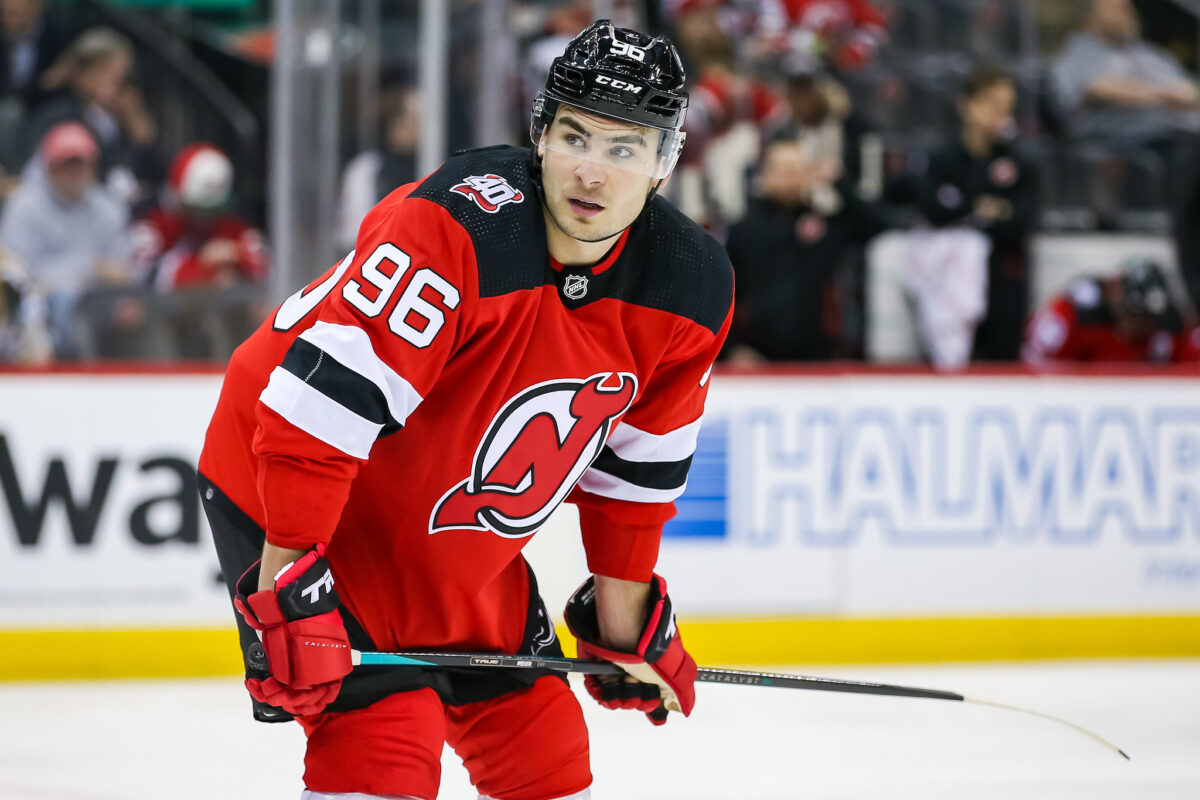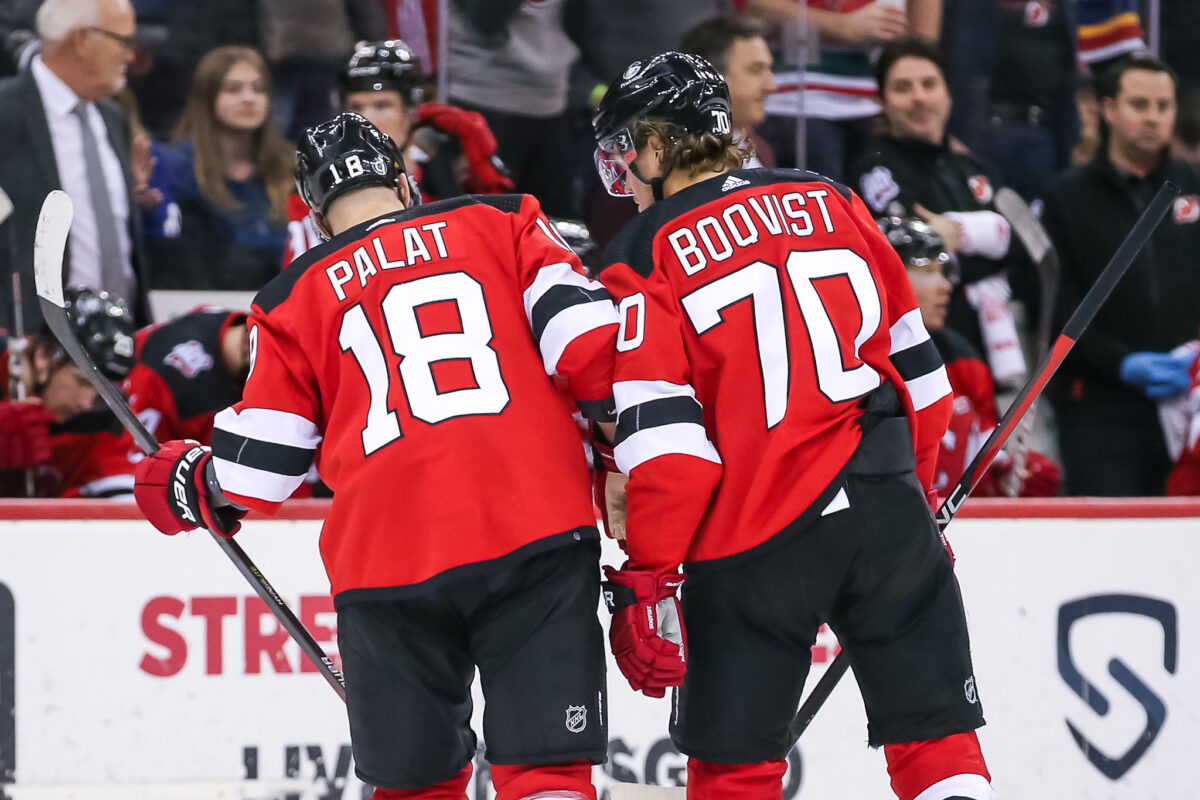The best NHL teams always have one or two go-to line combos that head coaches rely on, but for the most part, they don’t stay together for all 82 games. Even in-game, coaches tend to mix them up depending on the situation, like trailing and looking for a goal or trying to get the right matchup.
New Jersey Devils head coach Lindy Ruff is no stranger to mixing and matching his lines, especially in-game. Most of his in-game moves work, even if the team doesn’t always start hot out of the gate. But with the playoffs a little over two weeks away, finding more consistency in his line combos could help a Devils team that’s 6-5-3 in March.
That’s especially true with the Devils’ top six, which feels like it’s had 20 different combinations lately. And with Ruff still looking to find the right fit for Timo Meier, it’d help to keep lines together for more than a period or two a game. Let’s look at some pairs Ruff could use to help the Devils’ line combos find more consistency.
Nico Hischier & Timo Meier
Since the Devils acquired Meier from the San Jose Sharks at the trade deadline, he’s played on about every line imaginable. That was especially true in the team’s 5-1 loss to the New York Islanders on March 27, which saw him play on the first, second and third shifts. Meier handled the shuffling well, posting the best expected goals percentage (xG%) among Devils skaters in the loss. Still, it’d help if Ruff let him settle in with one line, as he’s only played in 13 games with the team since the trade.
It feels like Meier has played with 13 different line combos, from on a line with Hischier and Jesper Bratt, to a unit with Jack Hughes and Bratt, to Erik Haula and Jesper Boqvist. But based on the numbers, his best results have come alongside Hischier.

In 63 minutes together, the Devils have an 83-54 shot attempt advantage — a Corsi for percentage (CF%) of 60.5 percent — and a 72.07 xG% with them on the ice. Those aren’t sustainable numbers as the sample size increases, but it’s hard to argue that Meier and Hischier wouldn’t continue to post strong five-on-five results. While they have played well with Bratt rounding out the trio, it makes more sense to have Bratt alongside Hughes (more on that in a bit).
Because of that, Ruff should give the line of Meier, Hischier and Dawson Mercer an extended look and not break them up after one or two periods. In their small sample size, Meier, Hischier and Mercer have looked quite good together. Mercer and Hischier have dominated with Tatar as their linemate, so there’s no reason to think they can’t continue to play well with Meier.
Related: Rangers-Devils Playoff Series Would Reignite Their Rivalry
Meier can play off the rush and forecheck and has experience playing alongside Hischier with the Swiss national team. Mercer has played very well alongside Hischier this season and, like Meier, can play off the rush but also go to work on the forecheck and cycle. It’s a combo that Ruff should give a long look over the final eight games since all three players complement each other well.
Jack Hughes & Jesper Bratt
Ruff has gone away from Hughes and Bratt at different points this season, but they’ve still spent plenty of time together. They’ve logged a decent sample of 475 minutes as linemates, and their results are nothing short of fantastic:
- 61.09 CF%
- 63.95 scoring chances share (SCF%)
- 64.55 high-danger chances share (HDCF%)
- 63.69 xG%
The Devils have dominated teams when these two are linemates. Now, it’s about finding the right fit to round out the rest of the line. Ruff has used Yegor Sharangovich alongside them, but at least for this season, that ship has seemed to sail. The two most obvious candidates are Ondrej Palát and Tatar.

Palát hasn’t been his usual self, at least when it comes to offensive production, since having groin surgery early this season, but he has played well alongside Hughes and Bratt. This trio has posted a 57.56 xG% in a small sample of 58 minutes, hence why Ruff gave them a look together in practice yesterday.
With that said, Tatar is probably the better fit alongside Hughes and Bratt. Tatar doesn’t light up the score sheet too often — he has 17 goals and 41 points on the season. But he has averaged 1.93 points per 60 minutes, a rate you’d expect of a top-six winger.
There’s more to Tatar’s game than scoring, too. He excels off the rush but can also create scoring opportunities in the offensive zone when the team isn’t attacking off the rush. He’s one of the team’s best play drivers and is a stout defensive forward. Couple that with what Hughes and Bratt already bring as top-six forwards, and the Devils could have a killer line that almost any team will have trouble defending.
Devils’ Top Six Fills Out the Bottom Six
With the top six in order, let’s look at how the Devils’ bottom two lines could shape up. At this point, it’s pretty simple, given who’s left on the roster. The third line should consist of Palát, Haula and Boqvist, who have played very well together as a trio. They only have a sample size of 70 minutes, but it’s probably the best third line Ruff has put together this season:
- 61.34 CF%
- 64.91 SCF%
- 78.13 HDCF%
- 73.54 xG%
This line has dominated teams because all three players complement each other well. Palát is a crafty playmaker and gets to work on the forecheck, Haula is a steady two-way presence, and Boqvist is one of the team’s best forecheckers and defensive forwards. Depth tends to get overrated in the playoffs; your star players have to be your star players. But if the Devils have a third line such as this in a first-round matchup against the Rangers, it could be a difference-maker in that series.

As for the fourth line, it will likely be the BMW Line of Miles Wood, Michael McLeod and Nathan Bastian once Bastian is healthy and good to go. That trio has been solid for a fourth line, posting a 51.19 xG% in 267 minutes together. Having said that, there’s a good argument to keep Sharangovich in over Wood.
For starters, Sharangovich is one of the team’s primary penalty killers. Wood doesn’t play meaningful special teams minutes, and his defensive impacts are among some of the worst in the league. Still, I think it’s probably a long shot Ruff gives Sharangovich minutes over Wood. He seems to like the physical edge Wood provides, plus some of his speed and physicality.
Key to Consistent Devils Line Combos
With all that, that leaves us with these line combos, not all that different than what Ruff used in practice yesterday:
- Meier – Hischier – Mercer
- Tatar – Hughes – Bratt
- Palát – Haula – Boqvist
- Wood – McLeod – Bastian
The key to consistent line combos is keeping Meier and Hischier as one pair and Hughes and Bratt as the other. You can rotate wingers (Tatar with Hischier and Meier, and Mercer with Bratt and Hughes, for example). But keeping those pairs together, given their chemistry this season, seems like the right decision.
It’d also help to keep Meier with one consistent line to help him settle in and really start finding the scoresheet before the playoffs begin. These line combos could be the ideal arrangement for him, and they may be the setup that makes the most sense for Ruff and the Devils heading into the postseason.
* * *
Advanced stats from Natural Stat Trick